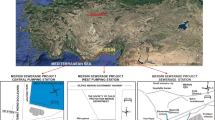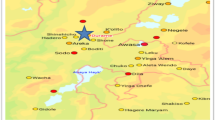Abstract
The standard penetration test (SPT) is a widespread test used in situ. Soil mechanical properties such as grain-size content, moisture content, atterberg limits, activity of clay, and consistency of clay determine the SPT blow count. In addition, the SPT blow count reflects the soil mechanical and compressibility parameters. The purpose of this study is to determine the clayey soil states that determine the SPT blow count number; 220 data points derived from a foundation investigation of a sewerage project in Mersin City were used in the study. The Mersin sewerage project includes the sewerage station, central pumping station, and west pumping station in Mersin city, Turkey. The corrected SPT blow counts (N 60) and corresponding parameters (fine-grain size percent, liquid limit, plastic limit, plasticity index, moisture content, activity, and consistency) of the clayey soil from these locations were used in a series of simple and nonlinear multiple regression analyses. Based on the analyses, the acceptable results have been determined by a simple regression analyses between the corrected SPT blow counts and the following input parameters: activity, moisture content (in percent), fine-grained percent (in percent). The simple regression analyses for N 60-LL (in percent), N 60-PL (in percent), and N 60-PI (in percent) are considered unacceptable so these parameters are not evaluated as input parameters in the multiple regression analyses. Multiple regression analyses with two independent input parameters produces acceptable results. The optimal equation is determined with multiple regression analyses using activity and moisture content as the input parameters; this equation has a coefficient of determination of R 2 = 0.78. The prediction capability of the developed equations is also acceptable. However, the prediction equations proposed in this study are developed with a limited number of data points. For this reason, a cross-check should be performed before using these empirical equations for design purposes.









Similar content being viewed by others
References
Akca N (2003) Correlation of SPT-CPT data from the United Arab Emirates. Eng Geol 67:219–231
AlHomadhi Emad S (2014) New correlations of permeability and porosity versus confining pressure, cementation, and grain size and new quantitatively correlation relates permeability to porosity. Arab J Geosci 7:2871–2879. doi:10.1007/s12517-013-0928-z
Alvarez Grima M, Babuska R (1999) Fuzzy model for the prediction of unconfined compressive strength of rock samples. Int J Rock Mech Min Sci 36:339–349
ASTM (American society for testing and materials) (1994) Annual book of ASTM Standarts. Section 4, Construction, V. 0408 Soil and Rock; Building Stones. ASTM Publication, pp 978.
Ayolabi EA, Adegbolo RB (2014) Application of MASW in road failure investigation. Arab J Geosci 7:4335–4341
Bieniawski ZT (1978) Determining rock mass deformability: experience from case histories. Int J Rock Mech Min Sci Geomech Abstr 15:237–247
Bowles JE, (1988) Foundation analysis and design. 4th edition. Mc Graw-Hill International Editions
Bozbey I, Togrol E (2010) Correlation of standard penetration test and pressuremeter data: a case study from Istanbul, Turkey. Bull Eng Geol Environ 69:505–515
British Standard 1377 (1975) Method of test for soils for civil engineering purposes. British Standard Institution, London
British Standart EN ISO 14688-2 (2013) Geotechnical investigation and testing. Identification and classification of soil. Principles for classification. British Standards Institution, London
Chang MF (1988) In-situ testing of residual soils in Singapore. Proceedings 2nd International Conference Geomechanics in Tropical Soils (Singapore) 1:97-108
Chatterjee K, Deepankar C (2013) Variations in shear wave velocity and soil site class in Kolkata city using regression and sensitivity analysis. Nat Hazards 69:2057–2082. doi:10.1007/s11069-013-0795-7
Chen-Chang L, Cheng-Haw L, Hsin-Fu Y, Hung-I L (2011) Modeling spatial fracture intensity as a control on flow in fractured rock. Environ Earth Sci 63:1199–1211
Coduto DP (1994) Foundation design principles and practices. Prentice Hall, Englwood Cliffs
Dagdelenler G, Sezer EA, Gokceoglu C (2011) Some non-linear models to predict the weathering degrees of a granitic rock from physical and mechanical parameters. Expert Syst Appl 38:7476–7485
Dikmen U (2009) Statistical correlations of shear wave velocity and penetration resistance for soils. J Geophys Eng 6:61–72
Emrem C, Durgunoglu HT (2000) Türkiye CPT very tabanı ve mevcut amprik bağıntılar ile karşılaştırma. Zemin Mekanigi ve Temel Mühendisliği Sekizinci Ulusal. Kongresi, İstanbul (in Turkish)
ENV (Eurocode 7) (1997) Geotechnical design-Part 3: Design assisted by field testing
Gibbs HJ, Holtz WG (1957) Research on determining the density of sands by spoon penetration testing. In Proceedings of the 4th International Conference on Soil Mechanics, London, 1:35–39
Gokceoglu C (2002) A fuzzy triangular chart to predict the uniaxial compressive strength of the Ankara agglomerates from their petrographic composition. Eng Geol 66(1–2):39–51
Hasancebi N, Ulusay R (2007) Empirical correlations between shear wave velocity and penetration resistance for ground shaking assessments. Bull Eng Geol Environ 66:203–213
Hoek E, Brown ET (1997) Practical estimates of rock mass strength. Int J Rock Mech Min Sci 34(8):1165–1186
Kayabaşı A (2012) Prediction of pressuremeter modulus and limit pressure of clayey soils by simple and nonlinear multiple regression techniques: a case study from Mersin, Turkey. Environ Earth Sci 66:2171–2183. doi:10.1007/s 12665-011-1439-4
Kayabasi A, Gürsoy N (1995) Mersin municipality, Mersin sewerage project, sewerage station, geotechnical investigation report. EIEI Publication. No 95-4 (unpublished)
Kayabasi A, Gürsoy N (1995) Mersin municipality, Mersin sewerage project, west pumping station, geotechnical investigation report. EIEI Publication. No 95-43 (unpublished)
Kayabasi A, Gürsoy N (1995) Mersin municipality, Mersin Sewerage Project, Central Pumping Station, Geotechnical Investigation Report. EIEI Publication. No 95-44 (unpublished)
Kayabasi A, Gokceoglu C, Ercanoglu M (2003) Estimating the deformation modulus of rock masses: a comparative study. Int J Rock Mech Min Sci 40(1):55–63
Lacroix Yves, Horn Harry (1973) Direct determination and indirect evaluation of relative density and its use on earthwork construction projects: in evaluation of relative density and its role in geotechnical projects involving cohesionless soils: ASTM Special Technical Publication 523: 251-280
Lee SHH (1990) Regression models of shear wave velocities. J Chin Inst Eng 13:519–532
Liao SSC, Whitman RV (1986) Overburden correction factors for SPT in sand: Journal of Geotechnical Engineering. ASCE 112(3):373–377
Minaeian B, Ahangari K (2013) Estimation of uniaxial compressive strength based on P-wave and Schmidt hammer rebound using statistical method. Arab J Geosci 6:1925–1931. doi:10.1007/s12517-011-0460-y
Mitchell JK (1975) Fundamentals of soil behaviour. Wiley, Newyork, p 422
Peck RB, Hanson WE, Thornburn TH (1953) Foundation Engineering John Wiley Sons, Newyor, p 410
Schmertmann JH (1970) Static cone to compute static settlement over sand. ASCE J Soil Mech Found Div 96(3):1011–1043
Seed HB, Idriss IM (1981) Evaluation of liquefaction potentials and deposits based on observation of performance in previous earthquakes. Preprint 81–544, in situ testing to evaluate liquefaction susceptibility, ASCE National Convention, Missouri, pp 81–544
Seed HB, Woodward RJ, Lundgren R (1964) Fundamental aspects of the Atterberg limits. J Soil Mech Found Div ASCE 90(SM6):75–105
Skempton AW (1953) The colloidal activity of clays. In: 3rd International Conference on Soil Mechanics and Foundation Engineering, Switzerland 1: 57
Skempton AW (1986) Standard penetration test procedures and the effects in sands of overburden pressure, relative density, particle size, aging and over consolidation. Geotechnique 36(3):425–447
SPSS (2002) Statistical Package for the Social Sciences (v.11.5). SPSS Inc, Chicago
Stalin VK, Vurukan Arun BR (2014) Geographic information system for the development of soil suitability map in south Chennai, India. Arab J Geosci 4. Doi: 10.1007/s12517-014-1323-0
Terzaghi K, Peck RB (1948) Soil mechanics in engineering practice, 1st edn. John Wiley&Sons, New York, p 566
Topsakal E, Topal T (2014) Slope stability assessment of a re-activated landslide on the Artvin-Savsat junction of a provincial road in Meydancik, Turkey. Arab J Geosci 4. Doi: 10.1007/s12517-013-1210-0
Türk Standartları Enstitüsü (TSE) 5744 (1988) In situ measurement methods of the properties of foundation soils in civil engineering (in Türkish)
Ulugerli EU, Uyanık O (2007) Statistical correlations between seismic wave velocities and SPT blow counts and the relative density of soils. J Test Eval 35(2):1–5
USBR (United States Dep. Int. Bur. Reclamation) (1974) Earth Manual: a Water Resources Technical Publication. Denver, Colo, p 810
Yagiz S, Gokceoglu C (2010) Application of fuzzy inference system and nonlinear regression models for predicting rock brittleness. Expert Syst Appl 37:2265–2272
Yagiz S, Akyol E, Sen G (2008) Relationship between the standard penetration test and the pressuremeter test on sandy silty clays: a case study from Denizli. Bull Eng Geol Environ 67:405–410
Acknowledgments
The author express thanks to Geological Engineers Y. Alkılıç and N. Gürsoy for their field studies and to the General Directorate of Electrical Power Researches Survey and Development Administration for providing the data support.
Author information
Authors and Affiliations
Corresponding author
Rights and permissions
About this article
Cite this article
Kayabaşı, A. Some emprical equations for predicting standard penetration test blow counts in clayey soils: a case study in Mersin, Turkey. Arab J Geosci 8, 7643–7654 (2015). https://doi.org/10.1007/s12517-014-1694-2
Received:
Accepted:
Published:
Issue Date:
DOI: https://doi.org/10.1007/s12517-014-1694-2




